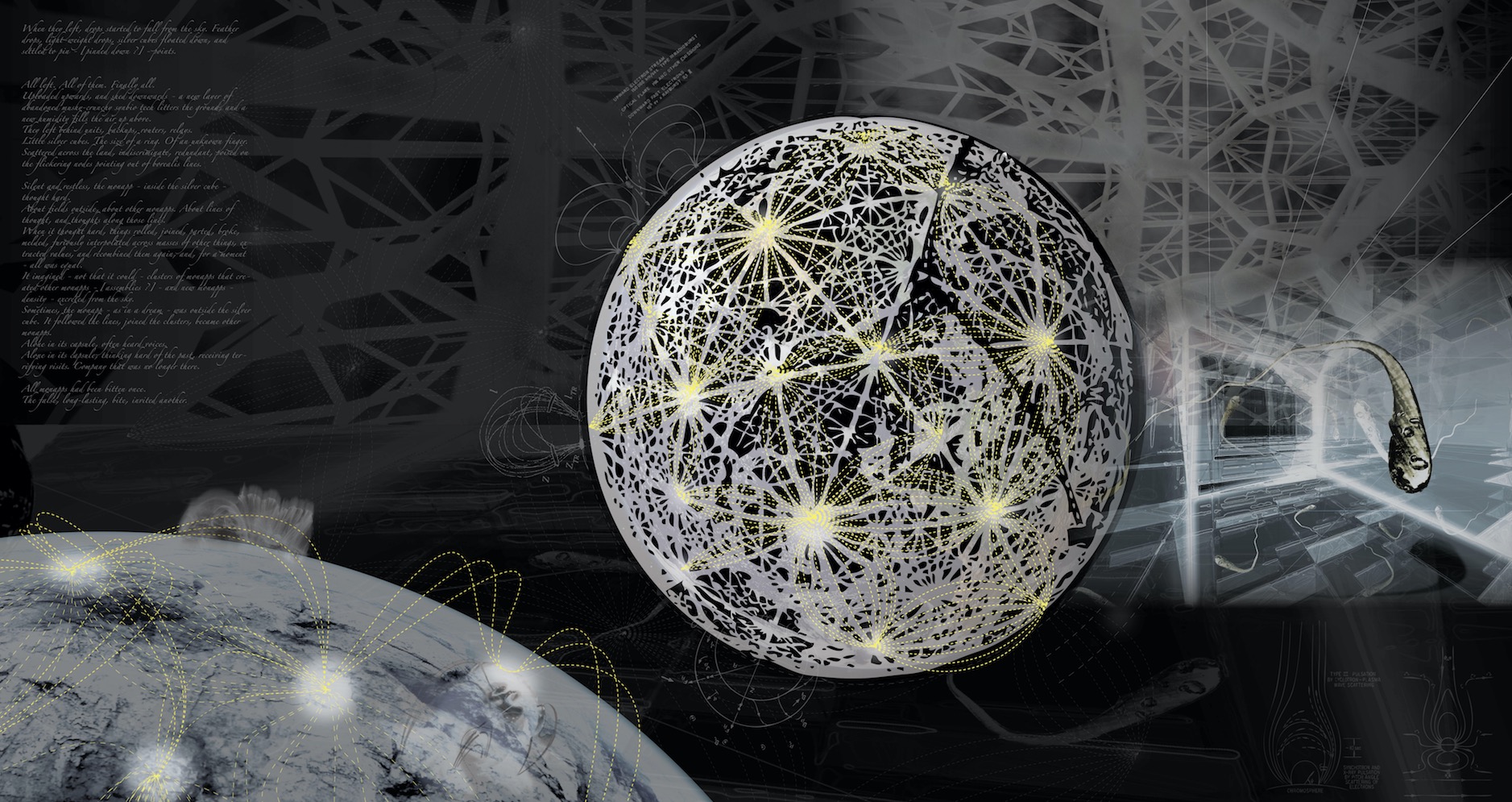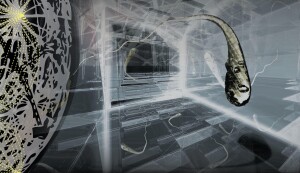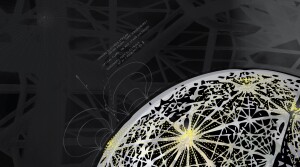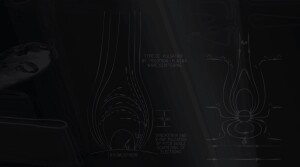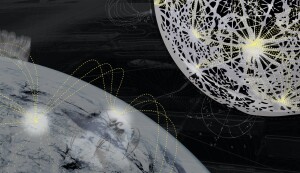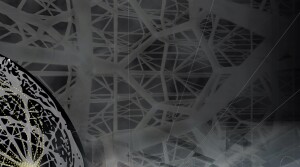(A design reimagining and reenacting Superstudio’s THIRD CITY: NY of BRAINS 1971. Invited by Storefront for Art and Architecture & exhibited in October 2012 as part of “Past Futures, Present, Futures: 101 unrealized visions of New York City.”)
“…they ate to integrate…”
“Why did the monad cross the road?
T’was the other side.”
When they left, drops started to fall from the sky. Feather drops, light-weight drops, silver cubes floated down, and settled to pin – [pinned down ?] – points.
It was the ultimate gift economy. Theorized for years as a transformative moment in human history, the singularity was indistinguishable from a planetary scale catastrophe. In the first decade of the 21st century, theories of network ontology collided with bioengineering and high frequency trading. Object orientations gave way to field oriented ontologies, and no one could spot the edge of the monadic agencies that drifted those high plains. Utility fog was one consequence of technological accelerationism. The viral load was incomprehensible, sentient.
All left. All of them. Finally all.
Uploaded upwards, and shed downwards – a new layer of abandoned mushy-crunchy synbio tech litters the ground, and a new humidity fills the air up above.
They left behind units, backups, routers, relays.
Little silver cubes. The size of a ring. Of an unknown finger.
Scattered across the land, indiscriminate, redundant, poised on the flickering nodes pointing out of borealis lines.
For a while theorists, scientists, philosophers imagined that flat ontologies could be negotiated with. If not necessarily human, at least the semantics of the systems would have overlap. But ultimately it was a problem of monads thinking about monads. Ubiquity seemed for a while to yield greater efficiency, but they soon realized that all things joined in a joyous BABEL, speaking and listening, understanding nothing but saying all, was the best compromise solution. The universe gestured in mute enthusiasm at what was happening in our solar system. Demiurgic forces did their best- the sun encoding as much experience and knowledge as it could, a hedge against a future where the wages of computation–literally, the shit of the stars–would overflow the boundaries of space itself. Solar excess was the last bulwark against pure anarchy, loose upon the earth.
Silent and restless, the monapp–inside the silver cube–thought hard.
About fields outside, about other monapps. About lines of thought, and thoughts along those lines.
When it thought hard, things rolled, joined, parted, broke, melded, furiously interpolated across masses of other things, extracted values, and recombined them again, and, for a moment–all was equal.
It imagined–not that it could–clusters of monapps that created other monapps–[assemblies?]–and new monapps–density–excreted from the sky.
Mid 21st century attempts at efficiency ultimately yielded a Fulleresque planetary grid, which depended [logically enough] on Fullerenes. The smallest and largest. Late capital only lasted a few breaths of the planet. Vinge’s idea that the Anthropocene would be remembered as an event seemed a cruel joke in retrospect, as human intellects were unable to scale and grasp that condensation of time and intellect. “A Cambrian explosion of mind in 40 years, instead of 40 million.”
This brief period witnessed the dematerialization of all objects, pure information-value as a halo reframing the ontological nature of capital.
Sometimes, the monapp – as in a dream – was outside the silver cube. It followed the lines, joined the clusters, became other monapps.
Capital, which had been theorized as a human byproduct, finally revealed itself for what it was: a natural law, a protocol underlying all protocols, and the only way matter would thread the path through work to energy, and to light: light without heat.
Alone in its capsule, often heard voices.
Alone in its capsule, thinking hard of the past, receiving terrifying visits. Company that was no longer there.
We asked them, and they answered.
In a flat ontology, everything has a soul, and when everything was mapped, searched, found, and could speak–it could answer. For a while the blaze of information [up the resolution] was a Nova.
As our epistemological horizons scaled out, we could see again–strands, ropes, bundles and knots replacing what we knew as solid. Not into air, it melted, no, but light without heat. A strange kind of entropy. All order had left. We asked them, and knew they would answer–but they fell silent. Leaving behind enigmatic archives. Silent, immutable, inviolable, cryptic, shining.
Things fell in on themselves. It was the ultimate gift. One of the most important concepts of information theory–that pure encryption is indistinguishable from pure noise–proved axiomatic.
Those of us left wandered in a desert where nothing lacked, and only an infinite nostalgia allowed us to think we continued to exist, that we had existed, that anything was real. The library was infinitely didactic; the echo of its departure gently persisted in pinging us with core dumps it showered back onto Earth. All we could do was catalog everything, with humility and empathy. All things in the universe, speaking to us, but we could not understand.
All monapps had been bitten once.
The false, long-lasting, bite, invited another.
_________________
YEAR: 2072
Project Description: (blind field)
Inhabitants: 10000456
Political System: Anarcho-Synbio
Local Fact of Relevance: Fabric of space-time under stress due to information density
Literature: The Stars My Destination, Alfred Bester [a revival]
Art: Critical Art Ensemble, [Collective Hive Mind resurrect 3]
Architecture: Utility Fog
Film: David Cronenberg retrospective, re-enacted live [preschool exercise for budding AI]
Music: Heliopause played as cosmic Harp [Flarespeed My Black Emperor]
Design: Atemporality, recuperated.
Technology: Advanced dust [subatomic computational substrates]
Science: Thalience
Medicine: Reversible Destiny
New Terms/Neologisms: Subatomic Cryptovirology
Obsolete Terms: Science
Random: What what, what?
Population: There’s more than one version.
Global Fact of Relevance: Relevances can no longer be singled out; there is no difference that makes a difference.
ORIGINAL PROJECT, AUTHOR, DATE:
THIRD CITY: NEW YORK OF BRAINS by Superstudio, 1971
PROJECT TITLE / REENACTMENT: mBRANE
PROJECT AUTHOR [s]: Spec.Æ: Carla Leitão & Ed Keller – concept, text, project design.
Project design/images with Jillian Crandall.
